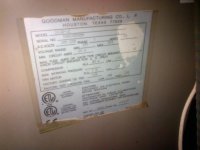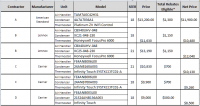Thanks so much guys, I can't tell you how appreciative I am for your feedback!
Ok, some of additional info from my wants and needs to AC are:
Yes I'm the same guy replacing my boiler+HW system too, and the design info that can be used can be
seen on this thread. Every thing I'm doing is living through a heartbeat to drive efficiency and value, so I greatly appreciate your feedback.
Other Notes of Interest:
Personally: I'm very hot natured. I use to work as a meat cutter for 12+ years. I think something is off with my internal clock, or it could be that I'm covered in hair!

... TMI, I know

That being said, please skew my needs towards one that cannot live without A/C. Being that I am from the south, I used AC on a regular basis. I don't know how some of the New England (born and raised) people do it. When house hunting in this area, I qwas amazed at the homes that either don't have one, or people that standby the fact they don't need one at all!
So for me, it's ok in April / May and probably even October to November, but June through September I'd rather NOT be without Central A/C running and need something for "comfort" on the edges of the season.
Other info:
All units quoted above are 3 Tons ----> Do I need 3 Tons? I don't understand how this math works either and could use some education.
My current system is a CK60-1C which I believe is 3 ton, coupled with a 5 ton blower. This is all builder quality grade stuff! and that is not a complement.

Home was built in 1997,and from what I gather is pretty good with insulation. Some the contractors point out that MassSave had been there easily and other than the R4 flex duct, insulation was pretty good.
My understanding is the duct system is going to either break or make any new systems efficiency. I also have two registers that are not blowing any air. So they are either not attached at all, or they are just for decoration?
Given that the contractors' Manual-Js overshot the heat load numbers by more than 12,000 BTU/hr , it wouldn't surprise me if they similarly oversized the AC,
To be fair and not sure if it matters, but the neither contractor was ever privy to my usage for their calculations.
Does this house have any foundation wall or slab insulation? How cold does the basement get when you don't actively heat it?
Home is a concrete basement is about all I know... It doesn't get terribly cold in the winter, It's not necessarily 2X6 construction either, I believe that came a few years later as it relates to code specs for a house around here. However the basement does get fairly hot in the mid to late summer. This is attributed in some part to the dehumidifier running non-stop. This tends to make it a little warmer at times. The basement does not currently have any duct work present, so I can only imagine it would make sense to implement a ductless system here, but not really focusing on that. However it now makes me ponder, how could incorporate something ductless now, with the impending condenser purchase I'm considering? Possibilities?? While there is no duct work present, basement location provides easy access to the current condenser and electrical panel.
However my main focus is on the 1st / 2nd floor for the new system, unless I can be enlightened by you fella's (and ladies if there are any here).
Another one of my wants is take this to a 2 Zone system by using the existing ductwork, and implementing motorized dampers and a maybe even a whole house air cleaner (family members have allergies)
Another thing I'm trying to do is make sure all the current flex duct is upgraded from R-4 to R-8
Also the return design of my current system is disfunctional meaning it doesn't have a filter which as lead the current system to a early failure and innefficiency.
Another question I have is ... Can a line-set be flushed and reused? Is it completely necessary to run a new lineset and what would be the difference in cost roughly ... If I'm saving 200-300 dollars but jeopardizing my warranty or systems performance ... well it's not really worth it to me. Also what is the likelyhood it would be an issue to use the current line-set after being flushed?
Finally, Do I really need an 18 SEER? Again I'm thinking efficiency, but the steep prices I'm seeing have me thinking maybe there are other possiblities out there, thoughts?





